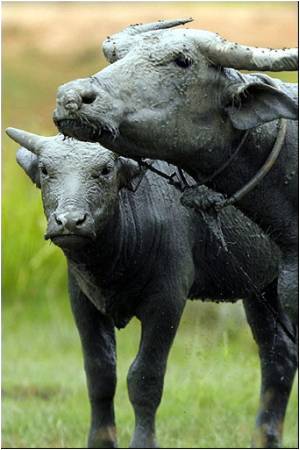As we see it from an aeroplane, the utter scale of farms in the heartland of North America is hard to comprehend. Each one of those squares or circles in the endless patchwork of maize and wheat, soya and alfalfa that rolls from horizon to horizon can measure a square mile-about 345 hectares, the standard unit for field sizes in this part of the world. Farmers rarely stroll through fields that big. They might send in a sprayer every few weeks, and finally a harvester. Otherwise, plants on which millions depend for food are on their own.
Let us suppose, that from a plane we see a small cloud of something emitted from a pickup truck on one of the deserted access roads. You are the only person who saw it. No one notices that the crops have a new infection until harvest. Then the farmer may keep it quiet to protect the value of his crop, or perhaps the infection shows itself only when the crop is eaten, or when next year's seeds are planted.
Suppose it was a wheat field and the cloud was spores of a wheat smut. The fungus has little impact on the harvest because US wheat is bred to resist it. But the disease is on the exclusion list of every wheat-importing country in the world. The US loses a billion dollars in exports, there is economic ruin in the wheat belt, world grain prices rise and hunger and unrest stalk some Third World cities.
There again, perhaps it was a maize field, and the cloud was millions of whiteflies carrying a usually harmless maize virus that has been genetically engineered to make botulinum toxin. The toxin turns up in beer made partly with maize, and sickens some people. Next year, more maize is affected as local whiteflies acquire and spread the virus. Another food scare. Another government's credibility in tatters. The US launches a billion-dollar whitefly control programme and burns thousands of hectares of farm land.
Or it could have been a soya bean field, and the cloud was an aerosol of Pseudomonas tabaci-a bacterium that produces deadly tab toxin. Relatively few fields are affected, but soy is used throughout the food industry. The contaminated batch kills some cattle, then a few people. Too small an outbreak to count as a major threat to public health, but enough to fuel a massive food scare. US soya exports grind to a halt. World fodder and meat prices skyrocket.
Unbelievable scare stories? Crop bioterrorism may not have made it on to the agenda in Europe, but a growing band of plant pathologists and defence analysts in North America claim that if your aim is to wreak economic damage, destabilise governments, or simply get a business advantage, there are few easier targets than those lonely waves of grain. No one is claiming that such attacks have already happened-although that has not been ruled out. But at a symposium on anti-crop bioweapons at the Joint American and Canadian Phytopathological Society meeting in Montreal in August, they argued that measures must be taken now to stop bioterrorist strikes against crops becoming inevitable.
Crop diseases are not a new temptation. By the time the US renounced biowarfare in 1968, it had stockpiled 30 000 ton of wheat stem rust spores to drop on the Soviet Union, and a tonne of rice blast for Asia. The Soviet Union stockpiled wheat stem rust, and pathogens of maize and rice. Iraq had a wheat smut bomb.
But what has changed is the objective of crop biowarfare and the ease with which a "biobomb" might be deployed. The military motive has traditionally been to deprive an enemy of food during wartime, says Mark Wheelis of the University of California at Davis, who studies bioweapons for the Federation of American Scientists in Washington DC. This goal was so difficult to achieve, he says, that it helped convince the US to abandon crop weapons research when it did. Terrorists, on the other hand, don't need to annihilate the whole harvest to disrupt trade or discredit authorities. If that's the goal, a little plant disease-or the rumour of it-goes a long way.
Even in rich countries the average city has only enough food to last five days, writes Wallace Deen, a consultant formerly with the US biological defence programme, in a report published in November in the Annals of the New York Academy of Sciences. In poor countries, a slight reduction in harvest can raise staple food prices for the urban poor enough to spark civil disturbance. Witness Indonesia after the Asian financial crisis in late 1997-relatively small price rises for rice fuelled food riots in major cities around the country.
Health scares might be a better way to destabilise governments in the wealthy West. At the Montreal symposium, "everyone thought it significant that it only took a little bit of dioxin in Belgium last summer to create a food scare, ruin the livestock industry, destroy food exports and bring down the government," says Norm Schaad, of the Foreign Disease and Weed Science Unit in Fort Detrick, Maryland, part of the US Department of Agriculture (USDA). "A terrorist might do the same with only a small outbreak of the right crop disease."
Political or ideological enemies needn't be the only targets-rivals for export markets may also be tempting. China, a major maize exporter, would benefit if disease blighted US maize, and vice versa. Even corporations could get in on the act. "Say one company grows pineapples in countries where production is limited by a pathogen, which does not occur in countries where a rival operates. The first company might even out this trade advantage by spreading the pathogen," says Wheelis.
|


















